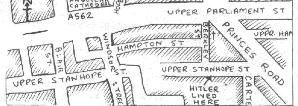MANY CELEBRITIES have visited the city of Liverpool over the years. Literary giants such as Daniel Defoe, Charles Dickens, Herman Melville, Mark Twain and Nathaniel Hawthorne have all visited the town, as well as prominent historymakers such as Lord Nelson, Theodore Roosevelt, Winston Churchill - and even his adversary, Adolf Hitler.
According to an unfinished manuscript that was discovered in a New York public library in the late 197Os, Adolf Hitler came to stay in Toxteth, Liverpool when he was a young down-and-out draft-dodger. The author of the incredible manuscript was one Bridget Hitler, the wife of Adolf's half-brother, Alois. Bridget had married Alois Hitler after a whirlwind romance when the two met in Dublin at the annual Horse Show there in 1909. The couple later moved to Liverpool, where Alois tried his hand at a succession of business ventures which left him bankrupt. Able put what little money he had left on a horse in the Grand National, and it won him a fortune. Alois used the winnings to go into the safety-razor business, and decided to move to 102 Upper Stanhope Street, Toxteth, an area of the city where many Germans had settled.

One freezing November morning in 1912, Alois and Bridget stood at Lime Street Station, waiting for Anton Raubal, the brother-in-law of Alois to disembark from a London to Liverpool steam train. Anton had been summoned by Alois to help with his newly-founded razor business. But Anton Raubal didn't step down from the train. A pale-faced young man in a worn-out suit descended instead and offered his hand to Alois. It was his 23-year-old half-brother, Adolf.
Adolf explained that Anton could not make the Journey, so he had come in his place. Alois was furious and started to argue with Adolf in German.
During his stay at the three-bedroomed house in Upper Stanhope Street, young Adolf confessed he was in Liverpool because he had deserted from the Austrian army, and had been on the run for eighteen months. He had managed to slip out of Germany by using the altered identity papers of his dead brother Edmund Hitler.
Adolf spent most of his time lounging about the house and playing with his brother's two-year-old baby He often spread a large map of Europe on the kitchen floor and told how Germany would one day rise and conquer the world, and would rant on about the Jews in Vienna who turned down his application to enter the Academy there. He occasionally wandered aimlessly around the town until nightfall, and often visited the Walker Art Gallery, where he admired a huge painting of Napoleon that still hangs over the gallery staircase. Adolf also spent hours down at the Pier Head, watching the ships on the Mersey. At that time, Britain and Bavaria shared the same national anthem tune, and when Adolf heard a brass band at the Pier Head playing God Save the King, he couldn't believe his eyes when all the old men present took off their hats and stood to attention.
Adolf eventually outstayed his welcome, and Alois
told him to go home. In May 1913, Adolf Hitler left and returned
to Germany. Bridget says in her manuscript that she
blamed herself for turning loose a man who plunged the world
into war, and regretted not getting him
to learn English. Historians who
have analysed the manuscript believe the alleged trip to Liverpool
Is entirely credible, and furthermore, November 1912 to May
1913 is something of a lost period in the Fuhrer's life. Hitler never
mentioned his stay in Liverpool in Mein Kampf, but then that could be because
he didn't want to publicise his shameful days as a draft-dodging drop-out.
Ironically, the last bombs to fall on Liverpool in WWII demolished
the house in Upper Stanhope Street where Hitler once lived.